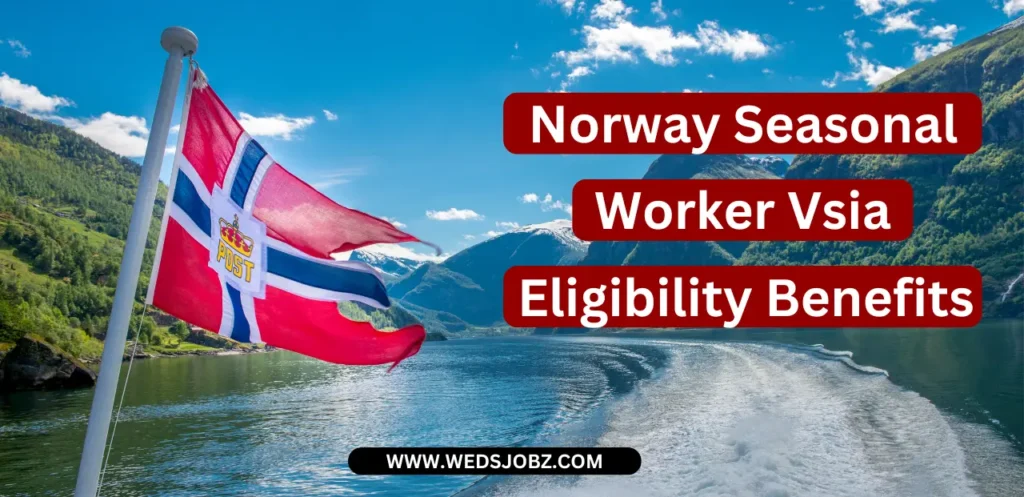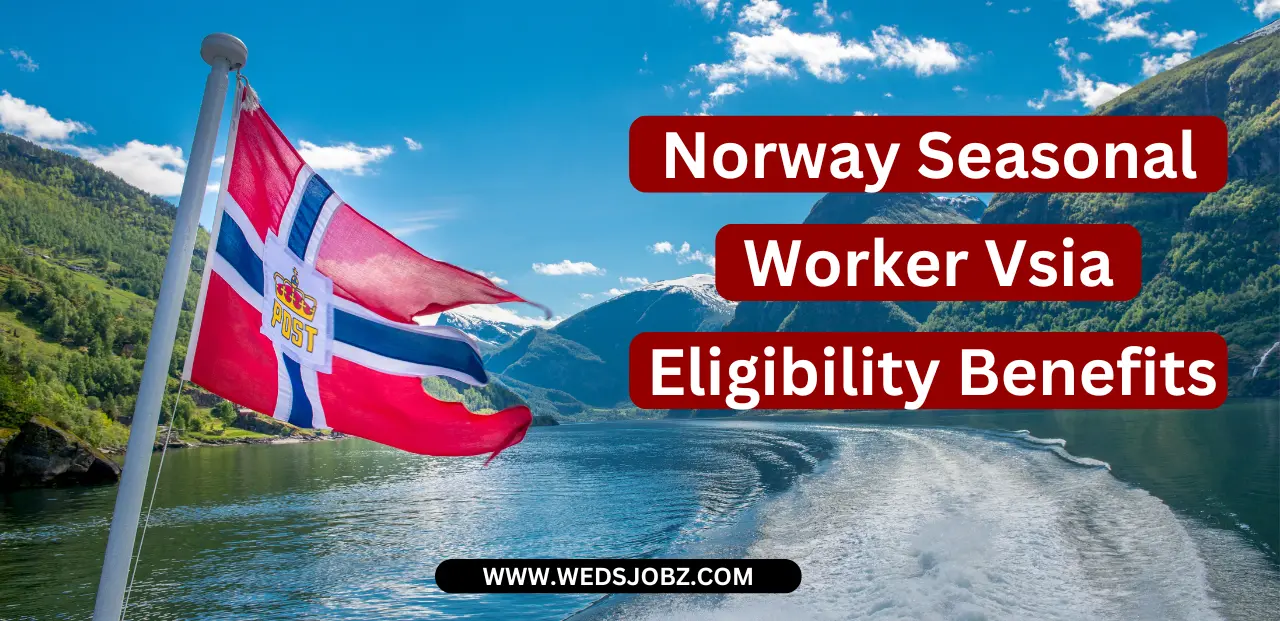Are they thinking about getting involved in a project in Norway? If the specialist is not from an EEA country, you’ll need to apply for a work permit for them. This article explains what you need for that application and why more companies are looking at Norway for business opportunities.
Regarding taxes in Norway: The income tax rate is 22%. It’s progressive, so people with lower incomes pay a smaller percentage. There is no inheritance or gift tax, as it was removed on January 1, 2014. Property tax is usually set by the local area. If it exists, for personal and vacation homes, it generally ranges from at least 1% to a maximum of 4%.
Also Apply: France Skill Shortage Occupations

What is Norway’s Seasonal Work Visa?
When it comes to job opportunities around the world, countries like Italy, Spain, Canada, and the United States often get the most attention. However, if you’re looking for a different way to experience a vibrant culture, Norway is a great option for seasonal work. This Nordic country welcomes foreign workers from all over, offering an exciting chance for those seeking global job experiences.
Moving to Norway through seasonal work contracts is one of the easiest and most affordable ways to immigrate legally. Typically lasting no more than 8 weeks, this option lets you enjoy Norway’s beautiful landscapes and rich culture. However, there are certain requirements and conditions you need to meet to get a visa to enter Norway.
Requirements
Here’s what you need for your Norway work visa application:
- Your Visa: Include copies of all the pages in your passport.
- Application Form: After completing the online application on the UDI website, download the PDF version of the Norway Work Visa Application Form. Print it out and attach it to your other documents.
- Photos: Provide two recent passport-sized photos with a white background.
- Proof of Accommodation: Show proof of where you’ll stay in Norway, like a rental contract. If you haven’t arranged housing yet, include a letter explaining where you plan to live and how you’ll find a place.
- Job Offer Form: Your employer needs to fill out this form, which is available on the UDI website.
- Salary Proof: Provide evidence that your salary meets the requirements, such as your employment contract showing your pay.
- Educational Qualifications: Include proof of your education, like your college or trade diploma.
- Work Experience: Provide documents from past employers that detail your job roles, duration of employment, and qualifications.
- Resume/CV: Include your current resume or CV.
- Legal Residency: If you live in a country other than your home country, make sure you’re there legally and have had a residence permit for the last six months.
- Application in Norway: If you submit your application while in Norway, it proves you’re living there legally.
- If Your Employer Applies for You: Include the Power of Attorney form, which you can download from the UDI website.
Documents Required
Here’s a simplified checklist in table form:
| Situation | Documents Required |
|---|---|
| If you may work for more than one employer | Provide all necessary documents for each job |
| If you do not have a permanent job contract | Include relevant documents for temporary work |
| General Document Requirements | Download the document checklist from UDI |
| Original and Copies | Submit original documents and copies |
| If your employer applies for you | Only copies may be needed |
| Language Requirements | Translate documents not in English or Norwegian |
| Additional Documents | Be prepared to provide extra documents if requested by the UDI |
Benefits
First, you should decide if you need a work permit. Depending on your nationality and the job you plan to do, you might not need one:
For EU/EEA Citizens:
- You don’t need a work or study permit in Norway. However, if you stay for more than three months, you must register with the local police.
For Non-EU Citizens:
- You will usually need a work permit. You can use the Norwegian Migration Authorities’ online tool, where you enter your nationality and the reason for your visit to find out your visa options.
Vacation and Leave Policies:
- According to Norwegian law, workers are entitled to at least 25 working days off each year, which equals four weeks and one day (since Saturdays count as working days).
- Most Norwegian employers offer at least five weeks of vacation, totaling 30 days off per year.
- Employees earn vacation pay of 10.2% of their average salary from the previous year.
Parental Leave:
- Women are entitled to nine weeks of paid maternity leave, starting three weeks before the birth and lasting until six weeks after.
- Fathers can take two weeks of unpaid paternity leave after the birth.
- Both parents can take 48 weeks of paid parental leave, funded by the Norwegian Work and Welfare Administration (NAV).
- In addition to paid parental leave, each parent can take up to 12 months of unpaid leave to care for their children.

How to Apply?
Once you receive a job offer in Norway, you’ll need to apply for a Work Visa online at the Norwegian Directorate of Migration (UDI) website. Here’s what to do next:
If you are in Norway:
- Submit your completed application along with the required documents at the local government office or a Visa Application Center.
If you are not in Norway yet:
- Gather all the necessary documents for the work visa application.
- Complete the online application on the UDI website.
- Submit your application at the nearest Norwegian embassy or Visa Application Center (VAC). They will send your application to UDI in Norway.
After applying:
- If you need a visa to enter Norway, the UDI will send your entry visa to the embassy or VAC where you applied. You will use this visa to enter Norway and start working. You do not need to apply for a separate entry visa.
Conclusion
Norway stands out as a remarkable destination in the world. This Scandinavian nation is not only known for its stunning landscapes but also for its thriving economy. With a strong focus on innovation and sustainability, Norway is attracting significant foreign investment, especially in sectors like technology, renewable energy, and maritime industries.
The government actively supports businesses and encourages international partnerships, creating a favorable environment for growth. As a result, the economy is steadily gaining momentum, making Norway an appealing choice for professionals and companies looking to explore new opportunities in a dynamic market.
Also Apply: Admin Assistant Jobs in Canada
FAQS
What makes Norway an attractive destination for foreign investment?
Norway is appealing due to its strong focus on innovation, sustainability, and a booming economy. The government actively supports businesses and promotes international partnerships, creating a favorable environment for growth.
Which sectors in Norway are seeing significant foreign investment?
Key sectors attracting foreign investment include technology, renewable energy, and maritime industries. These areas are rapidly developing and offer many opportunities for businesses and professionals.
How does the Norwegian government support businesses?
The Norwegian government provides various forms of support, including financial incentives, resources for startups, and initiatives to encourage collaboration with international partners, making it easier for companies to thrive.
Why is Norway considered a dynamic market for professionals?
Norway’s economy is steadily gaining momentum, and its focus on innovation and sustainability creates numerous opportunities for professionals looking to advance their careers in a progressive and supportive environment.









2 thoughts on “Norway Seasonal Worker Visa 2024: Eligibility, Benefits, and How to Apply”